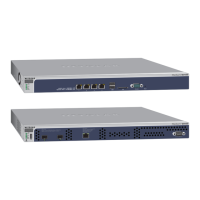Discover and Manage Access Points
157
ProSAFE Wireless Controller
Remote Access Point Discovery Guidelines
The following guidelines apply to the discovery of remote access points:
• Enable SNMP and SSH on all standalone access points.
• Unblock the following ports in the firewall at the site where the wireless controller is
located so that the remote access points can communicate with the wireless controller:
- For models WC7600 and WC9500:
• TCP port 22. Used by Secure Shell (SSH) and Secure Copy (SCP) for the
transfer of software images and large configuration files and for the transfer over
a tunnel.
• UDP port 69. Used by TFTP for software image upgrades of standalone access
points.
• UDP port 123. Used by Network Time Protocol (NTP).
• UDP port 138. Used by NetBIOS to resolve names.
• UDP port 161. Used by the SNMP discovery process.
• UDP port 6650. Used by the control channel between the wireless controller and
the remote access point.
• UDP port 7890. Used by the multicast discovery process. This port does not need
to be unblocked in a configuration in which remote access points are located
behind a NAT router.
- For models WC7500 and WC7600v2:
• TCP port 22. Used by Secure Shell (SSH) and Secure Copy (SCP) for the
transfer of software images and large configuration files and for the transfer over
a tunnel.
• TCP port 6670. Used for communication and backward compatibility with access
points that run an older firmware release.
• TCP port 6680. Used for communication and backward compatibility with access
points that run an older firmware release.
• UDP port 69. Used by TFTP for software image upgrades of standalone access
points.
• UDP port 123. Used by Network Time Protocol (NTP).
• UDP port 138. Used by NetBIOS datagram service.
• UDP port 161. Used by the SNMP discovery process.
• UDP port 6650. Used by the control channel between the wireless controller and
the remote access point.
• UDP port 7000. Used for Layer 3 roaming support.
• UDP port 7890. Used by the multicast discovery process. This port does not need
to be unblocked in a configuration in which remote access points are located
behind a NAT router.

